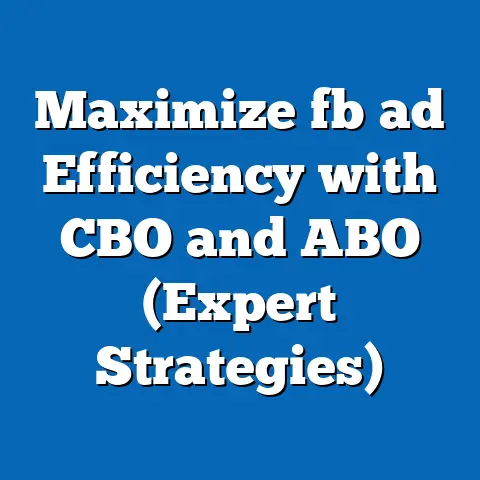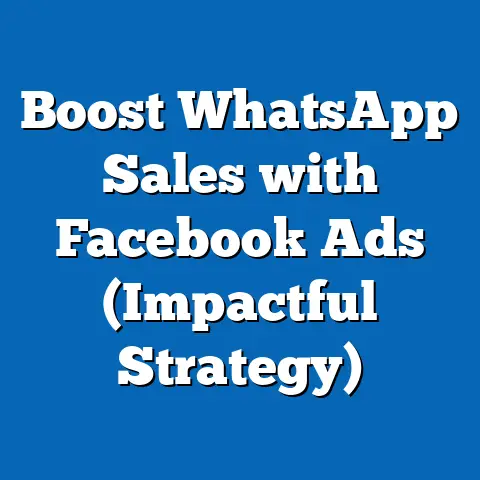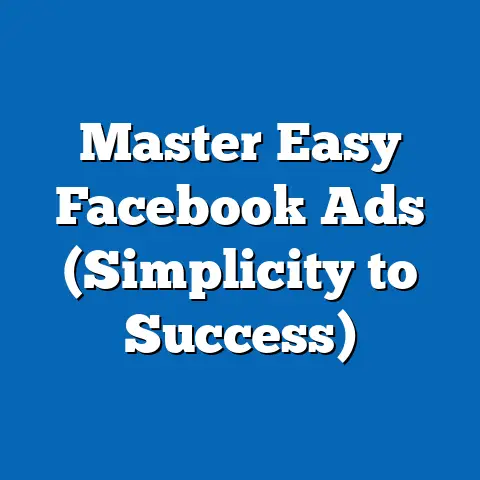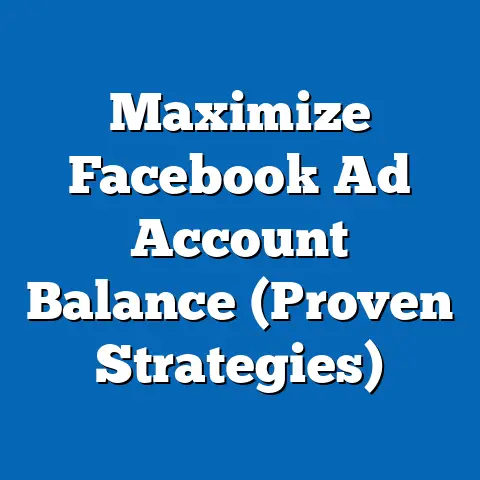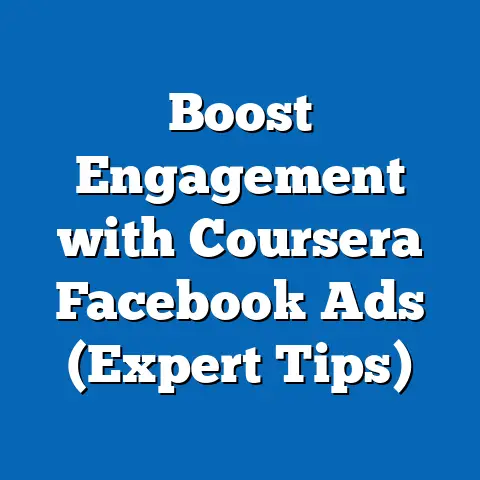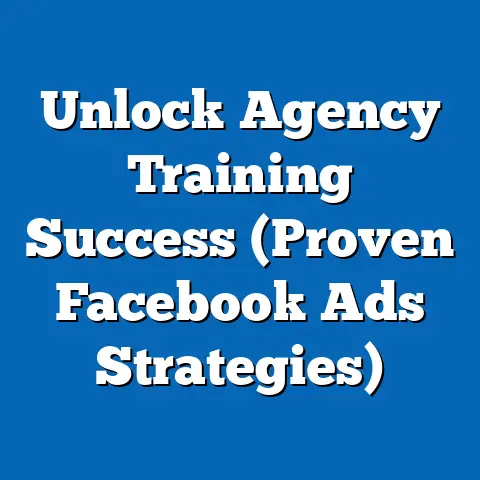Optimal Facebook Mobile Ad Images (Expert Size Guide)
As a digital marketing specialist with years of experience in running Facebook ad campaigns, I’ve learned one thing for sure: visuals are king! This is especially true when you’re targeting children and their parents. Think about it – what catches a child’s eye? Bright colors, engaging characters, and playful scenes. And what convinces a parent to click? Images that showcase the value, safety, and benefits of your product or service for their little ones.
In today’s mobile-first world, ensuring your Facebook ad images are perfectly optimized for mobile devices is no longer a suggestion; it’s a necessity. Parents are constantly on their phones, scrolling through Facebook, looking for the next great thing for their kids. If your ad looks blurry, cropped, or simply unappealing on their mobile screen, you’ve already lost the battle.
This guide will walk you through everything you need to know about creating optimal Facebook mobile ad images that resonate with both children and their parents. We’ll cover the importance of image size, Facebook’s specific requirements, design best practices for child-centric ads, optimization techniques for different mobile formats, and even recommend some handy tools to make your life easier. Let’s dive in!
The Importance of Image Size in Facebook Ads
Why does image size even matter? In the grand scheme of Facebook advertising, it might seem like a minor detail, but believe me, it’s anything but. Think of your ad image as the first impression you make on a potential customer. A blurry, distorted image is like showing up to a job interview with a ripped shirt – it immediately signals a lack of professionalism and attention to detail.
On mobile, this is amplified. Mobile screens are smaller, and users are typically scrolling quickly. You have a fraction of a second to grab their attention. If your image isn’t crystal clear and properly sized, it’ll likely get skipped over.
Here’s why image size is crucial for mobile Facebook ads:
- Enhanced Engagement: A well-sized, visually appealing image is more likely to stop users in their tracks and encourage them to engage with your ad.
- Increased Click-Through Rates (CTR): When your image is clear and compelling, users are more likely to click on your ad and learn more about your product or service.
- Improved Ad Performance: Facebook’s algorithm rewards high-quality ads. Optimized images contribute to a better user experience, which can lead to lower ad costs and higher conversion rates.
- Professionalism and Credibility: A professionally designed and properly sized image projects a sense of credibility and trustworthiness, making your brand more appealing to potential customers.
It’s important to remember that mobile isn’t just a platform; it’s the platform. According to Statista, mobile devices account for approximately 80% of Facebook’s advertising revenue. If you’re not prioritizing mobile optimization, you’re leaving money on the table.
Takeaway: Don’t underestimate the power of a well-sized image. It’s the foundation of a successful mobile Facebook ad campaign.
Facebook Ad Image Specifications
Okay, let’s get down to the nitty-gritty. Facebook has specific image size requirements for different ad placements. Ignoring these specs is like trying to fit a square peg into a round hole – it’s not going to work, and you’ll end up with a messy result.
Here’s a breakdown of the recommended image dimensions for various Facebook mobile ad types:
- Feed Ads (Single Image):
- Recommended Size: 1200 x 628 pixels
- Aspect Ratio: 1.91:1
- Why this matters: Feed ads are the most common type of ad, appearing directly in users’ news feeds. This size ensures your image looks good on both smartphones and tablets. I’ve found that slightly larger images can also work well, as Facebook will scale them down without significant quality loss.
- Stories Ads:
- Recommended Size: 1080 x 1920 pixels
- Aspect Ratio: 9:16 (Vertical)
- Why this matters: Stories ads are full-screen and immersive, making them ideal for capturing attention. The vertical format is designed specifically for mobile viewing. I once ran a campaign with poorly sized Story ads, and the text was cut off on many devices. Lesson learned!
- Carousel Ads:
- Recommended Size: 1080 x 1080 pixels
- Aspect Ratio: 1:1 (Square)
- Why this matters: Carousel ads allow you to showcase multiple products or features in a single ad unit. The square format works well on mobile and allows users to swipe through different images. I’ve seen great success using Carousel ads to highlight different aspects of a children’s educational toy.
- Collection Ads:
- Recommended Size: 1200 x 628 pixels (for the cover image)
- Aspect Ratio: 1.91:1 (for the cover image)
- Why this matters: Collection ads are designed for e-commerce businesses, allowing users to browse and purchase products directly from the ad. The cover image is the first thing users see, so it’s crucial to make a strong impression.
- Instant Experience Ads:
- Recommended Size: Varies depending on the template, but generally, 1200 x 628 pixels is a safe bet.
- Aspect Ratio: Varies depending on the template.
- Why this matters: Instant Experiences are full-screen, interactive ads that load quickly on mobile devices. They provide a more engaging experience than standard ads.
- Recommended Size: 1200 x 628 pixels
- Aspect Ratio: 1.91:1
- Why this matters: Feed ads are the most common type of ad, appearing directly in users’ news feeds. This size ensures your image looks good on both smartphones and tablets. I’ve found that slightly larger images can also work well, as Facebook will scale them down without significant quality loss.
- Recommended Size: 1080 x 1920 pixels
- Aspect Ratio: 9:16 (Vertical)
- Why this matters: Stories ads are full-screen and immersive, making them ideal for capturing attention. The vertical format is designed specifically for mobile viewing. I once ran a campaign with poorly sized Story ads, and the text was cut off on many devices. Lesson learned!
- Recommended Size: 1080 x 1080 pixels
- Aspect Ratio: 1:1 (Square)
- Why this matters: Carousel ads allow you to showcase multiple products or features in a single ad unit. The square format works well on mobile and allows users to swipe through different images. I’ve seen great success using Carousel ads to highlight different aspects of a children’s educational toy.
- Recommended Size: 1200 x 628 pixels (for the cover image)
- Aspect Ratio: 1.91:1 (for the cover image)
- Why this matters: Collection ads are designed for e-commerce businesses, allowing users to browse and purchase products directly from the ad. The cover image is the first thing users see, so it’s crucial to make a strong impression.
- Recommended Size: Varies depending on the template, but generally, 1200 x 628 pixels is a safe bet.
- Aspect Ratio: Varies depending on the template.
- Why this matters: Instant Experiences are full-screen, interactive ads that load quickly on mobile devices. They provide a more engaging experience than standard ads.
Important Considerations:
- Text Overlay: Facebook recommends keeping text overlay on your images to a minimum (ideally less than 20%). Too much text can negatively impact your ad’s reach and performance.
- File Type: Use high-quality JPEG or PNG files.
- Image Resolution: Aim for a resolution of at least 72 DPI (dots per inch) for web use.
Takeaway: Always double-check Facebook’s current ad specs before creating your images. You can find the latest information on the Facebook Business Help Center. Adhering to these specifications will ensure your ads look their best on all mobile devices.
Best Practices for Designing Child-Centric Mobile Ads
Now that we’ve covered the technical aspects of image size, let’s talk about design. Creating ads that appeal to children is a delicate balance. You need to capture their attention without being overly flashy or misleading. And, of course, you need to reassure parents that your product or service is safe, educational, and beneficial for their kids.
Here are some best practices for designing child-centric mobile ads:
- Color Psychology: Colors have a powerful impact on emotions and behavior. Use vibrant, engaging colors like red, yellow, and blue to capture children’s attention. However, avoid using too many colors, as this can be overwhelming. In my experience, a well-balanced color palette is key.
- Relatable Imagery: Use images that children can relate to. Show children playing, learning, or interacting with your product in a positive way. Avoid using stock photos that look generic or staged. Authenticity is crucial. I once used a photo of my own child playing with a toy in an ad, and it performed significantly better than the stock photos I had previously used.
- Playful Fonts: Choose fonts that are fun, easy to read, and appropriate for children. Avoid using overly formal or complex fonts. Comic Sans is often ridiculed, but it can actually work well in certain contexts.
- Clear and Concise Messaging: Children have short attention spans, so your message needs to be clear and concise. Use simple language and avoid using jargon or technical terms. Focus on the key benefits of your product or service.
- Include a Call to Action (CTA): Tell users what you want them to do. Use clear and compelling CTAs like “Shop Now,” “Learn More,” or “Download Now.” Make sure your CTA is visually prominent and easy to click on mobile devices.
- Consider the Parent’s Perspective: Remember that parents are the decision-makers. Include elements that appeal to their concerns, such as safety certifications, educational benefits, or positive reviews.
- Highlight Value: Clearly communicate the value proposition of your product or service. What problem does it solve? How will it benefit their child?
- Test, Test, Test: A/B testing is your best friend. Test different images, colors, fonts, and messaging to see what resonates best with your target audience.
Example: Imagine you’re advertising a new educational app for toddlers. A good ad image might feature a smiling toddler using the app on a tablet, surrounded by colorful graphics and playful characters. The text overlay might read “Make Learning Fun!” with a clear “Download Now” CTA.
Takeaway: Designing child-centric ads requires a deep understanding of what appeals to both children and their parents. By following these best practices, you can create ads that are both engaging and effective.
Optimizing Images for Different Mobile Formats
As we discussed earlier, Facebook offers a variety of ad formats, each with its own specific image size requirements. But simply resizing your images to fit these specs isn’t enough. You need to optimize your images for each format to ensure they look their best on all mobile devices.
Here are some tips for optimizing images for different mobile formats:
- Vertical Images (Stories Ads): Vertical images are ideal for capturing attention on mobile devices. Use the full screen to showcase your product or service. Consider using video or animation to make your ads even more engaging. I’ve found that short, looping videos perform particularly well in Stories ads.
- Square Images (Carousel Ads): Square images are versatile and work well on both mobile and desktop. Use them to showcase multiple products or features in a visually appealing way. Make sure your images are high-quality and well-composed.
- Landscape Images (Feed Ads): Landscape images are the most common type of ad image. Use them to tell a story or showcase your brand’s personality. Make sure your images are relevant to your target audience and your ad copy.
- Adaptable Designs: Create designs that are adaptable to different formats. Use layered files that allow you to easily resize and reposition elements. This will save you time and effort in the long run.
- Mobile-First Mindset: Design your ads with mobile devices in mind. Consider how your ads will look on small screens and make sure they are easy to read and navigate.
- Testing is Key: Test your images in different formats to ensure they display correctly across all devices. Use Facebook’s Ad Preview tool to see how your ads will look on different smartphones and tablets.
Example: Let’s say you have a landscape image that you want to use in a Stories ad. Instead of simply stretching the image to fill the vertical screen, consider cropping it strategically or adding additional elements to make it more visually appealing. You could also use a tool like Canva to create a custom Stories ad template that incorporates your landscape image.
Takeaway: Optimizing your images for different mobile formats is essential for maximizing the impact of your Facebook ad campaigns. By taking the time to create adaptable designs and test your ads on different devices, you can ensure that your ads look their best on all screens.
Tools and Resources for Creating Optimal Ad Images
Creating high-quality ad images doesn’t have to be difficult or expensive. There are a variety of online tools and software that can help you design and resize your images quickly and easily.
Here are some of my favorite tools for creating optimal ad images:
- Canva: Canva is a user-friendly design platform that offers a wide range of templates specifically for Facebook ads. It’s perfect for non-designers and offers a free plan with basic features. I use Canva almost daily for creating quick and easy ad graphics.
- Adobe Spark: Adobe Spark is another great design tool that offers a variety of templates and features for creating social media graphics. It’s a bit more advanced than Canva but still relatively easy to use.
- PicMonkey: PicMonkey is a photo editing tool that allows you to resize, crop, and enhance your images. It’s a great option for making quick adjustments to your photos.
- Fotor: Fotor is another photo editing tool that offers a variety of features, including resizing, cropping, and adding filters.
- Adobe Photoshop: If you’re a more experienced designer, Adobe Photoshop is the industry standard for creating and editing images. It offers a wide range of features and tools for creating professional-quality graphics.
- Unsplash/Pexels: For high-quality, royalty-free stock photos, Unsplash and Pexels are excellent resources.
Hiring a Graphic Designer:
If you’re not comfortable designing your own ad images, consider hiring a graphic designer. A professional designer can create custom graphics that are perfectly tailored to your brand and your target audience. This can be a worthwhile investment, especially if you’re running large-scale ad campaigns.
Takeaway: There are a variety of tools and resources available to help you create optimal ad images. Choose the tools that best fit your needs and your budget. And don’t be afraid to experiment and try new things.
Conclusion
Creating effective Facebook mobile ad images for products or services aimed at children requires a strategic approach that combines technical expertise with creative design. By understanding the importance of image size, adhering to Facebook’s specifications, following design best practices, optimizing for different mobile formats, and utilizing the right tools, you can create ads that capture the attention of both children and their parents.
Remember, your ad image is often the first impression you make on a potential customer. Make it count!
Here’s a quick recap of the key takeaways:
- Image size matters: Optimized images lead to higher engagement, click-through rates, and overall ad performance.
- Follow Facebook’s specs: Adhere to the recommended image dimensions for each ad type to avoid cropping or pixelation.
- Design with children in mind: Use vibrant colors, relatable imagery, and playful fonts to capture their attention.
- Consider the parent’s perspective: Highlight safety certifications, educational benefits, and positive reviews to reassure parents.
- Test everything: A/B testing is your best friend. Test different images, colors, fonts, and messaging to see what resonates best with your target audience.
Next Steps:
- Evaluate your current Facebook ad images. Are they properly sized and optimized for mobile devices?
- Identify areas where you can improve your ad designs. Are you using the right colors, fonts, and imagery?
- Experiment with different ad formats and optimization techniques.
- Track your results and make adjustments as needed.
By following these steps, you can create Facebook mobile ad campaigns that are both effective and engaging, helping you reach your target audience and achieve your business goals. Now go out there and create some amazing ads!

